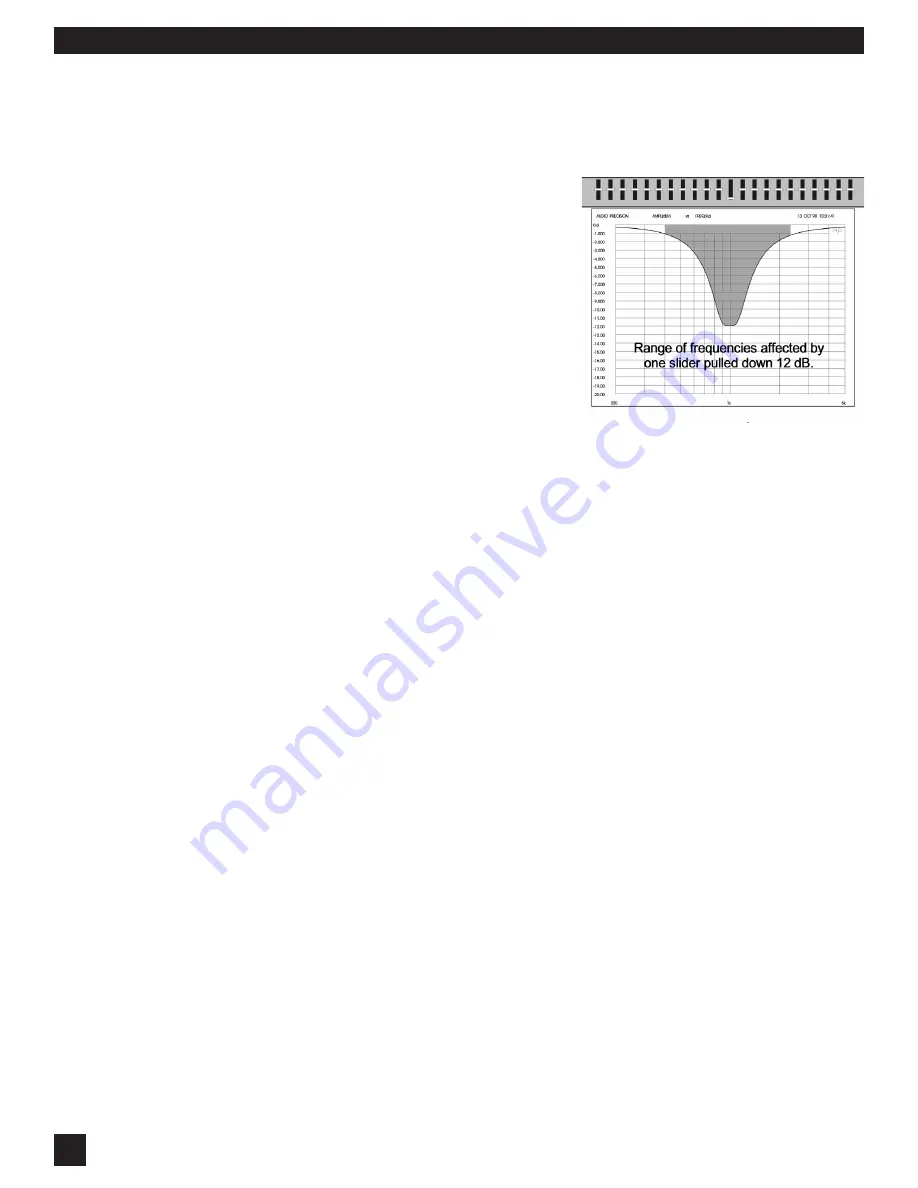
40
9.2. WIDE & NARROW FILTERS: GRAPHIC, PARAMETRIC, AND FBX
Here’s a trick question: how wide are the filters in a 1/3 octave graphic equalizer?
The answer to this question is not as obvious as the term “1/3 octave” would suggest. Much confusion
stems from the fact that “1/3” refers to the center points of the frequencies on a graphic equalizer, NOT
the width of the filters. In practice, most audio manufacturers conform to an informal industry norm that
sets graphic EQ filters to a one- octave width.
This means that moving a graphic EQ slider up or down
is not surgically precise, as you are actually controlling a
wide band of frequencies, in a roughly symmetrical “bell
curve” pattern centered on the nominal frequency. And
since the width of each filter (one octave) is greater than
the distance between adjacent graphic EQ center points
(1/3 octave), this wide swath of filters that you’re control-
ling with one slider actually overlaps the range of frequen-
cies controlled by sliders to the right and left. For example,
cutting the 1000 Hz EQ slider will also affect the 800 Hz
and 1.25 Hz slider frequencies, to a lesser but still signifi-
cant degree.
The diagram at right illustrates the wide cut of a single graphic EQ slider. Is the industry standard choice
of filter width a good or a bad design? It depends entirely on the intended use of the equalizer in question.
There are at least two basic design intentions of equalizers, both of which are designed into the Sabine
Graphi-Q:
•
SYSTEM EQUALIZATION
. Equalizers are used to achieve a desired system response curve, by
compensating for acoustical resonances of a particular environment, and for the characteristics of
particular audio gear (microphones, amplifiers, speakers, etc.). This kind of EQ is conducive to a
relatively large number of filters of greater width, which facilitates achieving a smooth overall
response. Narrow filter width produces more dramatic peaks and valleys in the response curve.
•
“PINPOINT” EQUALIZATION
. Equalizers are also used to correct very specific, relatively narrow-
band problems or deficiencies in audio signals. Common examples would include audio hum
induced by AC electrical current (50 or 60 Hz plus harmonic multiples of those frequencies), or
acoustical feedback that arises when amplified sound is directed back into a microphone or pickup
and re-amplified to the point of screaming oscillation. Using a wide, graphic EQ filter to correct hum
or feedback is overkill, since the filter is much wider than needed and unnecessarily affects
frequencies outside the narrow “problem band.” Using a graphic EQ filter to reduce feedback thus
has the unfortunate side effect of also subtracting a significant portion of the “good audio.” It’s like
throwing the baby out with the bath water.
In contrast to a graphic EQ filter, a PARAMETRIC filter affords a great deal of programmability. All the
“parameters” of a filter can be specified precisely: Filter width, frequency, and dBs of boost or cut. A
parametric filter can be much more “surgically” applied to an audio signal, sometimes with such
precision as to be transparent to the listener, while correcting or improving the signal.
The patented Sabine FBX filter is essentially a parametric filter that is
automatically activated when
acoustical feedback occurs. It is placed exactly at the frequency of the feedback, to the minimum depth
necessary to remove it, with a very narrow notch (typically 1/10 octave wide). The accuracy, narrow
width, and minimum depth of the FBX filter means it can be placed with little or no adverse affect on the
purity of the audio signal. In fact, because audio system gain is often limited by the onset of feedback
as volume rises, FBX-equipped sound systems are both louder and clearer than systems that rely on
alternative EQ filtering, or ignore feedback control altogether.
An additional very important benefit of the FBX algorithm is its ability to quickly and accurately distinguish
feedback from audio program, allowing the automatic placement of filters during performance as well
as setup.
Please note that graphic EQ and FBX filters are available using the front panel controls of your Graphi-
Q. Parametric filters can only be set using the Graphi-Q Remote Software, with an RS-232 connection
made to a computer controller.
S
ECTION
N
INE
: S
UGGESTIONS
FOR
O
PTIMAL
U
SE
OF
THE
G
RAPHI
-Q2
















































